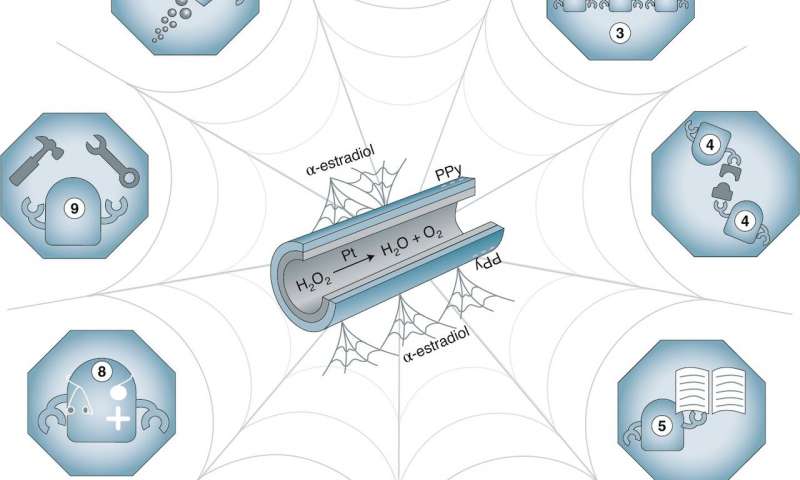
A team of researchers from the University of Chemistry and Technology Prague, Yonsei University and the Brno University of Technology has developed a micro-robot with chemically encoded intelligence that can remove hormonal pollutants from a solution. They have published their results in Nature Machine Intelligence. Dongdong Jin and Li Zhang with the Chinese University of Hong Kong and Multiscale Medical Robotics Center, respectively, have published a News and Views piece in the same issue outlining the state of micro-robot research and describe the work done by the researchers with this new effort.
As Jin and Zhang note, most micro-robots have little to no intelligence—they are single-purpose entities that are generally controlled externally using magnets. But they also note that micro-robot research is changing to add local intelligence, giving them the ability to interact with their environment as they carry out their functions. As an example, the researchers created programmable multi-layer micro-robots that are capable of removing hormonal pollutants from a solution without human assistance.
The micro-robots were three-layered, open-ended tubes. The most inner part of the tube was made of platinum. When immersed in a solution containing hydrogen peroxide, the H2O2 is catalyzed by the platinum, converting it to water and oxygen. During that process, the oxygen bubbles are ejected out one end of the micro-robot tube with enough force to propel it. Thus, the inner part of the micro-robot serves as the engine.
The outer part of the micro-robot was made of polypyrrole, and its purpose was to carry out the chemical reactions that resulted in decontamination of the solution. The researchers also added magnetite nanoparticles to the outer layer to provide the option of external control through the use of magnets. They note that as the pH level of the solution changed due to the actions of the robot, the surface charge on the outer layer of the micro-robots changed, as well, which led to affinity modulation. And as the micro-robot moved through the solution producing hormonal (estrogen) fibers, it created a web of sorts (made out of the fibers) on the surface of the solution, allowing for removal. And if that weren’t enough, when several of the micro-robots were put into the solution, they interacted with one another, forming a swarm, working together to create a single chunk of fiber that could be easily removed from the solution.
Lukas Dekanovsky et al. Chemically programmable microrobots weaving a web from hormones, Nature Machine Intelligence (2020). DOI: 10.1038/s42256-020-00248-0
Dongdong Jin et al. Embodied intelligence weaves a better future, Nature Machine Intelligence (2020). DOI: 10.1038/s42256-020-00250-6
© 2020 Science X Network
Citation:
Micro-robot with chemically encoded intelligence removes hormonal pollutants (2020, November 19)
retrieved 19 November 2021
from https://techxplore.com/news/2020-11-micro-robot-chemically-encoded-intelligence-hormonal.html
This document is subject to copyright. Apart from any fair dealing for the purpose of private study or research, no
part may be reproduced without the written permission. The content is provided for information purposes only.